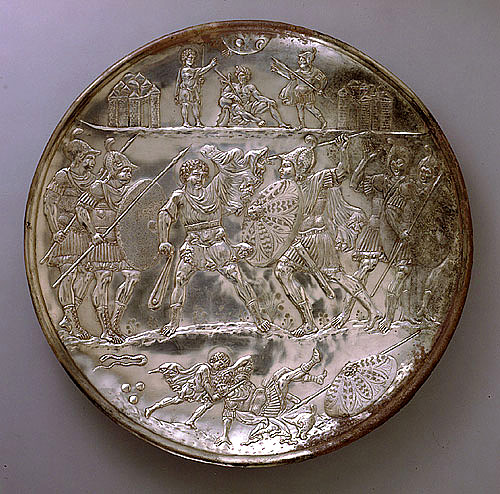David and Goliath

Constantinople, 628-630
Silver plate, 1½ in. (3.8 cm.), 19½ in. diameter (49.4 cm.)
Metropolitan Museum of Art, Gift of J. Pierpont Morgan, 17.190.396
The central image on the plate depicts the famous battle between David and Goliath in 1 Samuel 17:40-54. As described in 1 Samuel 17:5-7, Goliath carries a spear and is arrayed in armor, whereas David carries only his sling and has insisted on wearing only his ordinary shepherd's clothing. The "shepherd's scrip" with the "five smooth stones" hangs from his belt on the left. This image also gives him a cape, as does
this painting in the Catacombs of Domatilla.
In the upper register, the two antagonists stand on either side of a (personified) stream. Goliath taunts David, who points heavenward to God, his protector. (In 17:45, "Thou comest to me with a sword, and with a spear, and with a shield: but I come to thee in the name of the Lord of hosts.")
The lower register depicts the beheading of Goliath in verse 51. The snake on the left is likely to be more than decorative because it is repeated in exactly the same position on
a companion plate depicting David's anointing. It may be a reference to an epithet of David in the Vulgate 2 Samuel 23:8, sedens in cathedra sapientisssimus princeps inter tres, ipse est quasi tenerrimus ligni vermiculus, "seated on the throne among three [soldiers], he is as the most tender woodworm." The Mirror of Salvation uses this passage to compare David to Christ, mild and gentle but severe with his enemies. Also relevant to David's status as a type of Christ are what are taken to be his words in Vulgate Psalm 21:7, ego autem sum vermis, et non homo, opprobrium hominum, et abiectio plebis, "I am a worm and not a man, the reproach of men and rejected by the people."
This plate is part of a set displayed in the Byzantine Art gallery at the museum.
Read more about images of King David.
Photo: Metropolitan Museum of Art, New York City